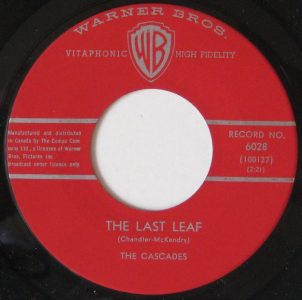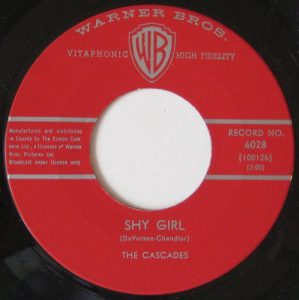#1002: The Last Leaf/Shy Girl by The Cascades
Peak Month: May 1963
9 weeks on Vancouver’s CFUN chart (The Last Leaf)
5 weeks on Vancouver’s CFUN chart (Shy Girl)
Peak Position #6
Peak Position on Billboard Hot 100 ~ #60/#91
YouTube.com: “The Last Leaf”
Lyrics: “The Last Leaf”
YouTube.com: “Shy Girl”
Lyrics: “Shy Girl”
The origins of The Cascades, a smooth pop harmony group, were born in 1960 aboard the U.S.S. Jason AR-8. When the ship wasn’t overseas in Sasebo, Japan, it docked in San Diego. The group initially consisted of singer and lead guitarist Lenny Green, singer and drummer Dave Wilson, bass player Dave Stevens and rhythm guitarist Art Eastlink. On and off ship they were known to other servicemen and local San Diegans’ as The Silver Strands. Fellow friend and serviceman on the U.S.S. Jason, John Gummoe, was a huge fan and started to serve as the group’s manager. Gummoe booked the group for five gigs a week. He also performed duets with Dave Wilson as part of the Silver Strands’ concerts. The group left the U.S. Navy and became billed as The Thundernotes. They released an instrumental surf single in the fall of 1961. “Pay Day” got airplay on the local San Diego radio station KDEO. Lenny Green left the group and John Gummoe officially joined the band as lead vocalist.
As the group switched from being an instrumental band to a vocal group, the lineup changed. By the summer of 1962, Gummoe’s bandmates were guitarist Eddy Snyder, keyboard player G. David Szabo, along with original Silver Strands members, Dave Stevens and Dave Wilson. Soon they billed themselves as The Cascades, inspired by a nearby box of dishwashing detergent while waiting to and recorded “There’s A Reason”, making #10 in San Francisco and #12 in San Diego in July ’62. Their second release with Valliant Records was “Rhythm Of The Rain”. The song went to #1 in the USA, Hong Kong, Singapore, Japan and Ireland. The song peaked at #3 on CFUN and spent 15 weeks on the chart in 1963. It tied for the second longest chart run for a single in Vancouver that year behind “She Loves You” by The Beatles.
“Rhythm of the Rain” was their only single to reach the Top 80 on the Billboard Hot 100 in the USA between 1962 and 1968. The Cascades had help in the studio with that hit from members of the Wrecking Crew ~ Jim Owens on drums, Carol Kaye on bass and Glen Campbell on guitar. “Rhythm of the Rain” ended up being the #3 song of the year for 1963. That year they shared the concert stage with many other recording artists including Annette Funicello, Bob B. Sox & The Blue Jeans, Fabian, Bobby Vinton, April Stevens and Nino Tempo and The Olympics.
In most radio markets in North America the Cascades were a one-hit wonder. However, in Vancouver the group charted nine singles into the Top 50, including four charted songs that reached the Top Ten. But even in Vancouver, it was only the groups follow up to their international hit inspired by John Gummoe seeing a thundershower, that got them any attention. This was the release of “The Last Leaf”, backed with “Shy Girl”.

“The Last Leaf” has a folk narrative sound resembling The Highwaymen. The song depends on a summer promise given by a girlfriend underneath a tree, that she’d return to her boyfriend before the leaves of autumn touched the ground. The song is sung at the point where all the leaves of this tree have fallen to the ground, except for one. A listener could be forgiven for wondering if the girlfriend might not have tried to phone her boyfriend to give him an update. Or, while watching the leaves fall, if the boyfriend might not muster the curiosity to make some phone calls and inquire about his girlfriend’s hoped-for return. The song was a reminder that being young and in love can be ridden with angst.
“The Last Leaf” spent three weeks in the CFUN top ten in Vancouver, peaking at #6. The tune did best in Honolulu, where it climbed to #2. It also reached #6 in Corpus Christi, Texas, and Newport News, Virginia. “The Last Leaf” also climbed the CHUM charts in Toronto to peak at #9. But on the national charts in America, the song stalled at #60.

“Shy Girl” was the B-side of “The Last Leaf”. Nonetheless, it did chart on numbers of radio markets in North America. Honolulu was also its best market where it climbed to #2. The tune made it to #8 in Toronto, #7 in Miami and #8 in Springfield, Massachusetts. On the Billboard Hot 100 the song peaked at #91. In Vancouver, as a double-sided hit, it charted to #6, though for four weeks fewer than “The Last Leaf”.
Many people have written about shyness. Here are several quotes:
“So many people are shut up tight inside themselves like boxes, yet they would open up, unfolding quite wonderfully, if only you were interested in them.” ~ Sylvia Plath, from Johnny Panic and the Bible of Dreams: Short Stories, Prose and Diary Excerpts
“I wondered how many people there were in the world who suffered, and continued to suffer, because they could not break out from their own web of shyness and reserve, and in their blindness and folly built up a great distorted wall in front of them that hid the truth.” ~ Daphne du Maurier, from the novel Rebecca.
“A man’s vanity is more fragile that you might think. It’s easy for us to mistake shyness for coldness, and silence for indifference.” ― Lisa Kleypas, Devil in Winter
“I never wish to offend, but I am so foolishly shy, that I often seem negligent, when I am only kept back by my natural awkwardness. […] Shyness is only the effect of a sense of inferiority in some way or other. If I could persuade myself that my manners were perfectly easy and graceful, I should not be shy.” ― Jane Austen, Sense and Sensibility
“We met a great many other interesting people, among them Lewis Carroll, author of the immortal “Alice”–but he was only interesting to look at, for he was the silliest and shyest full-grown man I have ever met except “Uncle Remus.” ― Mark Twain, Autobiography of Mark Twain: Volume 1
“Shy people are my favorites. The unmistakable glint of shyness in someone’s eyes can mesmerize me for years!”
― Avijeet Das
“I am the son and the heir of a shyness that is criminally vulgar…” Morrissey, from “How Soon Is Now?” by The Smiths
In The Cascades, “Shy Girl”, both the shy girl and her admirer are shy. This can make for a challenge to become introduced, as the shy girl always averts the eyes of the guy who is trying to make eye contact with her. Shyness can be appealing, a curse, a trait to be overcome or accepted as part of one’s personality. Nonetheless, shy people do find romantic partners, even if they happen to bump into someone at a library or bookstore.
The Cascades next five singles got airplay on CFUN. But the top position they managed among these releases on CFUN was #35 with “For Your Sweet Love” in December 1963.
In January 1966 singer-songwriter Bob Lind had a hit called “Elusive Butterfly” that climbed to #3 on the CFUN chart. The B-side of his hit single he also wrote called “Cheryl’s Goin’ Home”. As a budding folk-rock composer, Lind was covered by numbers of other recording artists. His B-side was was a Top 50 hit in the UK for Adam Faith. The folk-rock group, Blues Project, covered the song, as did Sonny and Cher. The Cascades added their stamp to the tune with a cover which became their first Top Ten hit in Vancouver since 1963, where it peaked at #7. South of the border the tune bombed where it peaked at #131, “bubbling” beneath the Billboard Hot 100.
John Gummoe left the Cascades in 1967, discouraged that the groups eight single releases after 1963 all failed to crack the Billboard Hot 100. Gummoe would later recall of his five years with the band, “we spent most of the time touring across the US and Canada playing small towns when we should have been playing big cities. It was all poorly handled.”
After Gummoe left the band, Gabe Lapano joined the Cascades as lead singer on their final Hot 100 single in 1969 called “Maybe The Rain Will Fall”. The group reformed twice, in 1995 and 2004, touring the USA and the Philippines, where they still had a following.
Broadcast Music Inc. (BMI) released its Top 100 Songs of the Century at the end of 1999, based on its statistics. The songs on the list were the Top 100 to receive airplay on radio or television in the U.S.A. “Rhythm of the Rain” ranked at #9. John Gummoe, who wrote the song, lives in Los Angeles. He has his own studio that he built in his home and continues to record new material.
November 2, 2017
Ray McGinnis
References:
John Gummoe, The Cascades, Rhythm of the Rain.com.
Austin, Jane. Sense and Sensibility. T. Egerton, Whitehall, England, 1811.
Morrissey, “How Soon Is Now,” lyrics, 1984
Twain, Mark. Autobiography of Mark Twain: Volume 1. Harper & Brothers, New York, NY, 1924.
du Maurier, Daphne. Rebecca. Victor Gollancz, London, England, 1938.
Plath, Sylvia. Johnny Panic and the Bible of Dreams: Short Stories, Prose and Diary Excerpts. Harper & Row, New York, NY, 1977.
“C-FUNTASTIC FIFTY,” CFUN 1410 AM, Vancouver, BC, May 18, 1963.
For more song reviews visit the Countdown.

Leave a Reply